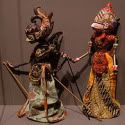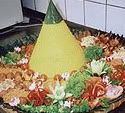
Elections in Indonesia
The Council is elected by proportional representation from multi-candidate constituencies. Under Indonesia's multi-party system, no one party has yet been able to secure an outright victory; parties have needed to work together in coalition governments.
The voting age in Indonesia is 17.
Upcoming Elections
Legislative elections for the Regional Representatives Council and the People's Representative Council were held in Indonesia on 9 April 2009, with results to be announced on 9 May. Presidential elections will take place later in the year. These will go to a second round if no candidate manages to win more than 50% of the vote.
Past Elections
1995
Indonesia's first general election elected members of the DPR and the Constitutional Assembly of Indonesia (Konstituante). The election was organised by the government of Prime Minister Ali Sastroamidjojo. Sastroamidjojo himself declined to stand for election, and Burhanuddin Harahap became Prime Minister.
The election occurred in two stages:
- The election of the members of the People's Representative Council, which took place on 29 September 1955. Twenty-nine political parties and individuals took part;
- The election for the members of the Constitutional Assembly, which took place on 15 December 1955.
The five largest parties in the election were the National Party of Indonesia (Partai Nasional Indonesia), Masyumi, Nahdlatul Ulama, the Communist Party of Indonesia (Partai Komunis Indonsia, PKI), and the Indonesian Islam Alliance Party (Partai Syarikat Islam Indonesia).
1971
This election, the first after the establishment of the "New Order", took place on 5 July 1971. Ten political parties participated.
The five largest political parties were Golkar, Nahdlatul Ulama, Parmusi, the National Party of Indonesia and the Indonesian Islam Alliance Party.
Elections under the New Order (1977-1997)
Elections following the mergers were held under the government of President Suharto. In accordance with the legislation, these were contested by three groups; Golkar, the PPP and the PDI. All elections in this period were won by Golkar.
To ensure that Golkar always won more than 60 percent of the popular vote, the New Order regime used a number of tactics. These included:
Reducing the number of opponents
In 1973, the existing political parties were forced to merge into the United Development Party (PPP) and the Indonesian Democratic Party (PDI). These were the only parties allowed to contest general elections.
Weakening the remaining opponents
The two political parties were forbidden to criticize government policy, and the government had to approve all slogans they used. Furthermore, they were not allowed to organize at the village level (where the majority of Indonesians live). To stop the rise of charismatic figures, their candidates had to be vetted by the government. When a potentially charismatic figure (in the form of founding president Sukarno's daughter Megawati Sukarnoputri) became leader of the PDI, the government engineered a political convention in Medan in 1996 to remove her. Ironically, the ensuing disturbances at the PDI's Jakarta headquarters began a chain of events that indirectly led to the downfall of the New Order.
Coercion to vote Golkar
Civil servants were ordered to support Golkar, or face accusations of insubordination. Private sector workers were reminded of the need for "stability". Many people believed the vote was not secret, and the government did little to persuade them otherwise. Many voters were still at school, and they were warned by teachers of a link between their choice at the ballot box and exam success
The vote-counting process
The Golkar votes were counted first, then those of the two other parties. In the 1997 election, by 9pm on the day after voting, Golkar had already been awarded 94% of its eventual vote. By contrast, the PPP had been credited with less than 10% of its final tally.
Vote-rigging
Although the counting at the local ballot boxes was conducted in public, with the ballot papers held up and the scores marked on boards, it was at the later stages where irregularities were frequently reported.
Multiple voting
There was no effective way of determining who had already voted, allowing many to do so more than once.
1999
The 1999 election was the first election held after the collapse of the New Order. It was held on 7 June 1999 under the government of Jusuf Habibie. Forty-eight political parties participated.
The six largest parties which passed the electoral threshold of 2% were the Indonesian Democratic Party-Struggle (Partai Demokrasi Indonesia Perjuangan), the reformed Golkar Party, the United Development Party (Partai Persatuan Pembangunan), the National Awakening Party (Partai Kebangkitan Bangsa), the National Mandate Party (Partai Amanat Nasional), and the Crescent Star Party (Partai Bulan Bintang).
Under the constitution, the new President was elected by members of both houses of Parliament in a joint sitting. This meant that although the Indonesian Democratic Party-Struggle won the largest share of the popular vote, the new President was not its nominee, Megawati Sukarnoputri, but Abdurrahman Wahid from the National Awakening Party. Megawati became Vice-President.
2004
The 2004 election was the second of the reform era. It was held on 5 April 2004. A total of 24 parties contested the election. The Golkar Party won the largest share of the vote, at 21.6%, followed by the Indonesian Democratic Party-Struggle, the National Awakening Party, the United Development Party and newly formed Democratic Party. 17 parties won legislative seats. (source)
Related articles :



















0 comments:
Post a Comment